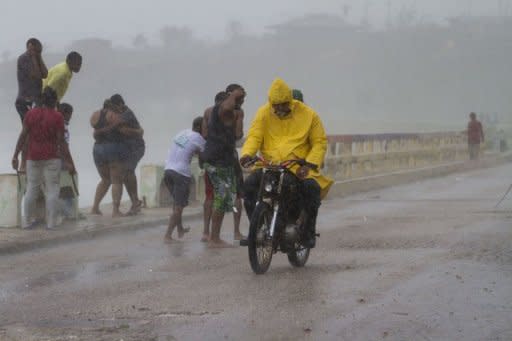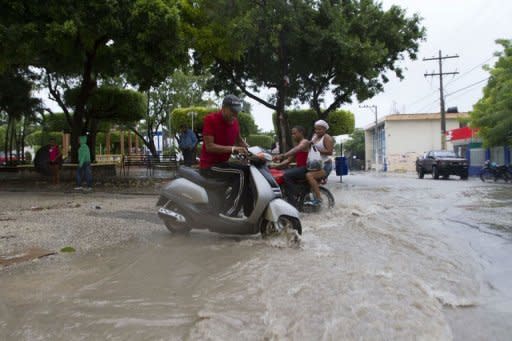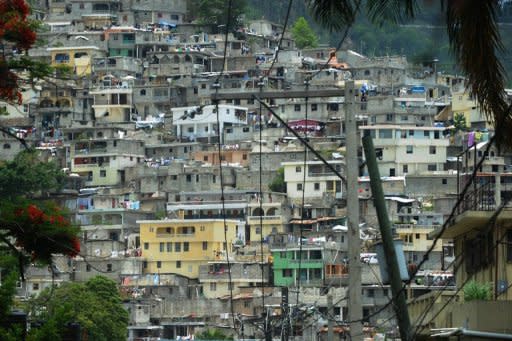Tropical Storm Isaac on course to strike Haiti
Tropical Storm Isaac gained strength Friday as it roared towards Haiti, where it was to make landfall later in the day, threatening survivors of a devastating 2010 earthquake. Rains had already begun lashing southern Haiti, and US forecasters said the storm was expected to be near hurricane strength when the eye makes landfall in Haiti, where people are still living in makeshift shelters. "Isaac strengthens a little more... The center of Isaac should make landfall in Haiti this evening, move near or over southeastern Cuba on Saturday," the US-based National Hurricane Center said in its 2100 GMT bulletin. "Little change in strength is likely before landfall," it said. Some 400,000 people still live in temporary tent camps following the earthquake that killed some 250,000 people and devastated Port-au-Prince. Long lines formed outside supermarkets in the Haitian capital as people filled stores to stock up on supplies. Those still without proper shelter after the quake "remain amongst the most vulnerable, should the storm hit the city," said Jean-Claude Mukadi, Haiti's national director for the humanitarian group World Vision. "Without a stable sanitation system or permanent housing, heavy rain and wind can create much larger problems like disease from water contamination." President Michel Martelly, who cancelled a trip to Japan, earlier took to the airwaves with safety advice and to urge Haitians to follow the directions of civil defense personnel. Prime Minister Laurent Lamothe said the whole government, including security forces, has mobilized to prepare for the storm. "We are going to work with our international partners to coordinate response actions," Lamothe said. A hurricane watch was in effect for Haiti, and a tropical storm warning was in effect for the neighboring Dominican Republic and eastern Cuba. A tropical storm watch was in effect for the Florida Keys and parts of south Florida. The Haiti director for Oxfam, another humanitarian group, said that his group was preparing clean water and hygiene kits to help prevent the spread of cholera and other water-borne diseases. "Nothing short of a miracle can keep people safe from this kind of storm when their only shelter is a tent," said Oxfam's Andrew Pugh. "Haiti's disaster preparedness and response capacities have improved since the earthquake, but much remains to be done to help the poorest people cope with hurricane-strength threats," he said. At 2100 GMT, Isaac was gathering strength and speed some 160 kilometers (100 miles) southeast of Port-au-Prince, the NHC said. Its maximum sustained winds were clocked at 100 kilometers per hour as it moved in a northwest direction at 26 kilometers per hour, it said. The storm could dump up to 20 inches (51 centimeters) of rain on Hispaniola. "These rains could cause life-threatening flash floods and mudslides," the NHC said. After striking Haiti and southeastern Cuba, home to the US naval base and "war on terror" prison at Guantanamo Bay, Isaac was due to head Sunday for the Florida Keys off the southern tip of the United States. In Cuba, the government declared a state of alert in the island's six eastern provinces, where nearly five million people live. Local authorities "must understand the possible impact of the intense rain on dams, canals and rivers," the Cuban civil defense office said, warning of blocked water drainage systems and flooded roads. Cuba's civil defense system was set up to resist a feared US military invasion but has proved effective at evacuating people and saving lives during past hurricanes. Isaac could reach Florida just in time for the Republican Party's National Convention. Tens of thousands of people from around the country will descend on Tampa for four days for the formal nomination of former Massachusetts governor Mitt Romney to challenge President Barack Obama in the November 6 election. City officials have urged residents to prepare for the worst, and Republican National Committee chairman Reince Priebus has expressed concern about the storm but insisted the show would go on. In the Gulf of Mexico, oil and gas operators braced for the storm, with BP evacuating its Thunder Horse platform, the world's largest offshore production and drilling facility.




